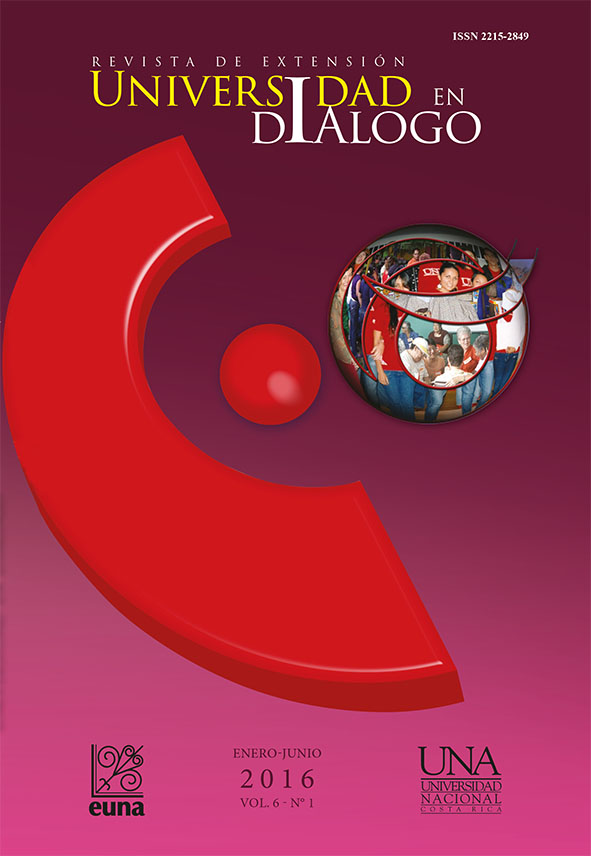System for art and identity in Mesoamerica and the Caribbean (SAVIA) of the ICAT program
DOI:
https://doi.org/10.15359/udre.6-1.9Keywords:
cultural identity, communication, computing platform.Abstract
In its research projects, the Program for Cultural Identity, Art and Technology (ICAT) always has worked closely with artists, communities, public and private institutions and national and international organizations. In these processes, we observed that the diverse entities and actors approach art in very different ways, generating proposals for creative exploration and research that are different, but at the same time-share issues and develop complementary methodologies. Despite this compatibility, there is little exchange beyond the borders of specific professions or fields of study, and spaces as forums, social networks and calls for papers or projects, that are crated in order to promote the exchange, tend to segregate art in categories that make it difficult to think beyond these bordures. It was because of this concern that the ICAT program decided to create the SAVIA project. SAVIA is a platform that seeks to encourage the exchange of materials, experiences and initiatives concerning the exploration, documentation and research of art and regional cultural identity, transcending the boundaries of specific occupations or fields of study. This encouragement is made through the development of shared documentation projects, an on-line platform, a system for the management of audiovisual material and activities aimed at creating a network of mutual support.
References
Arizpe, Lourdes (Coord.). (2011). Compartir el patrimonio cultural inmaterial: narrativas y representaciones. México: CONACULTA-UNAM.
Brown, Michael. (1998). Can Culture Be Copyrighted?. Current Anthropology 39(2), 193-222.
García-Canclini, Néstor. (2004). Diferentes, desiguales y desconectados. Mapas de la interculturalidad. Barcelona: Editorial Gedisa S.A.
Gerner, Vera (2011). Reflexiones acerca de la investigación audiovisual. La construcción de una antología de música afro-limonense. VI Jornadas Académicas 2011. Heredia: Vicerrectoría Académica, Universidad Nacional.
Gerner, Vera (2012). Las comparsas limonenses como espacios de negociación cultural. Boletín música 31, 75-83.
Gerner, Vera (2013). Implicaciones del audiovisual en la construcción de identidades. IV Congreso Centroamericano de Estudios Culturales. San José: Universidad de Costa Rica.
Gerner, Vera, Jeff Brenes, y Allan Barboza (2014). Huipiles: tejidos de identidad. (Sitio web). Heredia: Programa ICAT, Universidad Nacional. Recuperado de http://www.icat.una.ac.cr/savia/huipiles
Gerner, Vera (2014). ¿A quién le pertenece el arte? – una mirada al arte comunal como bien compartido, III Congreso internacional d Educación Superior. Heredia: Universidad Nacional y University of West Chester.
Gerner, Vera (2014). Construcción de significados identitarios a partir del arte: un ejemplo desde los huipiles de Guatemala, III Coloquio Internacional Repensar América Latina desde sus categorías culturales. San José: Universidad de Costa Rica.
Grant, Catherine. (2012). Rethinking Safeguarding: Objections and Responses to Protecting and Promoting Endangered Musical Heritage. Ethnomusicology Forum 21(1), 31-51.
McCann, Anthony. (2001). All That Is Not Given Is Lost: Irish Traditional Music, Copyright, and Common Property. Ethnomusicology, 45(1), 89-106.
Monge, Luis y Mora, Helberth. (2004). Un país dos mundos: Los bribris en Costa Rica. Heredia: Programa ICAT, Universidad Nacional.
Nivón, Eduardo & Mantecón, Ana (Coord.). (2010). Gestionar el Patrimonio en tiempos de Globalización. México: Editorial UAMI-Juan Pablos Editor.
Nowhere like Limón - Antología de música afocaribeña de Costa Rica. (2011). Heredia: Programa ICAT, Universidad Nacional.
Nusbaum, P. (2004). Folklorists at State Arts Agencies: Cultural Disconnects and “Fairness”. Journal of Folklore Research 41(2/3), 199-225.
OMPI. (s. f.). Propiedad Intelectual y Expresiones Culturales tradicionales o de Folclore. Folleto No.1. Ginebra: Organización Mundial de Propiedad Intelectual.
PNUD. (2004). Informe sobre el Desarrollo Humano 2004: La libertad cultural en el mundo diverso de hoy. Madrid: Grupo Mundi-Prensa.
Secretaría de la OMPI. (s.f.) Propiedad intelectual y expresiones culturales tradicionales o del folclore. Publicación No 913. Ginebra: Organización Mundial de Propiedad Intelectual.
Rojas, Alexander y Conte, Roberto. (2004). La mirada de las cadenas. Heredia: Programa ICAT, Universidad Nacional.
UNESCO. (2005). Convención sobre la protección y promoción de la diversidad de las expresiones culturales. Paris: UNESCO.
Downloads
Published
How to Cite
Issue
Section
License

La Revista y cada uno de los artículos que se publican están licenciados por Creative Commons Atribución No comercial Sin derivadas 4.0 Internacional.



